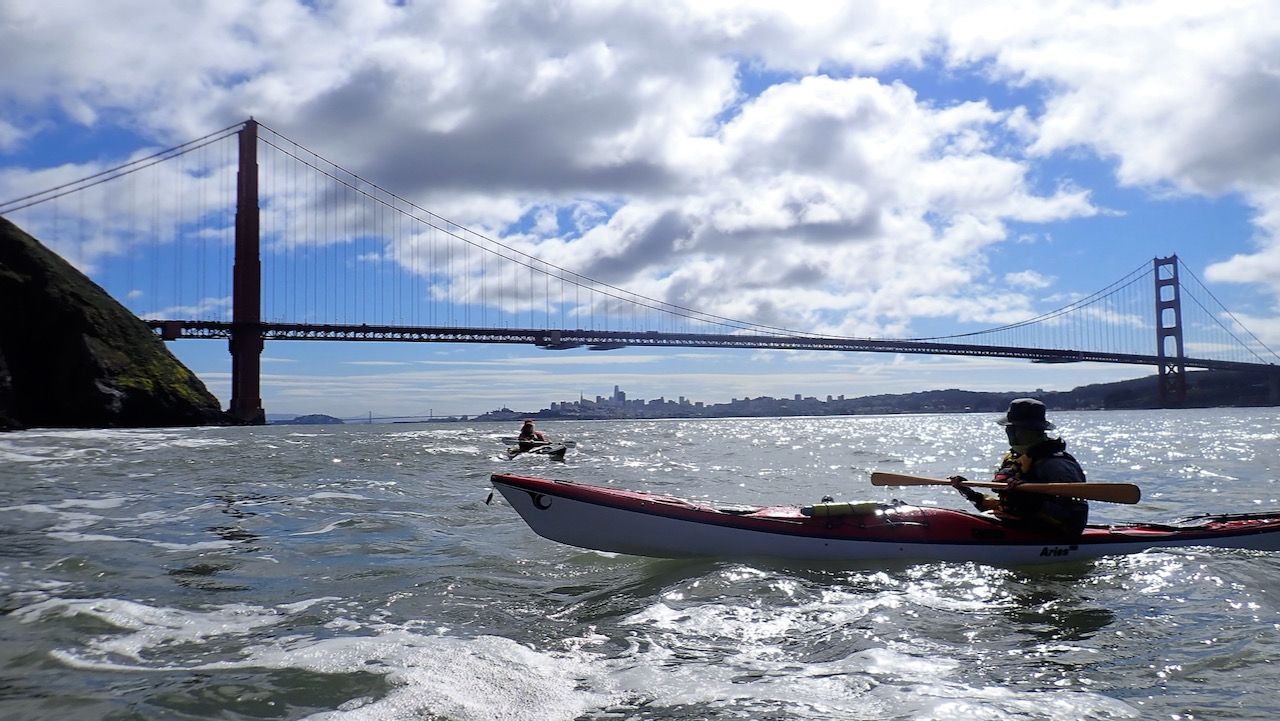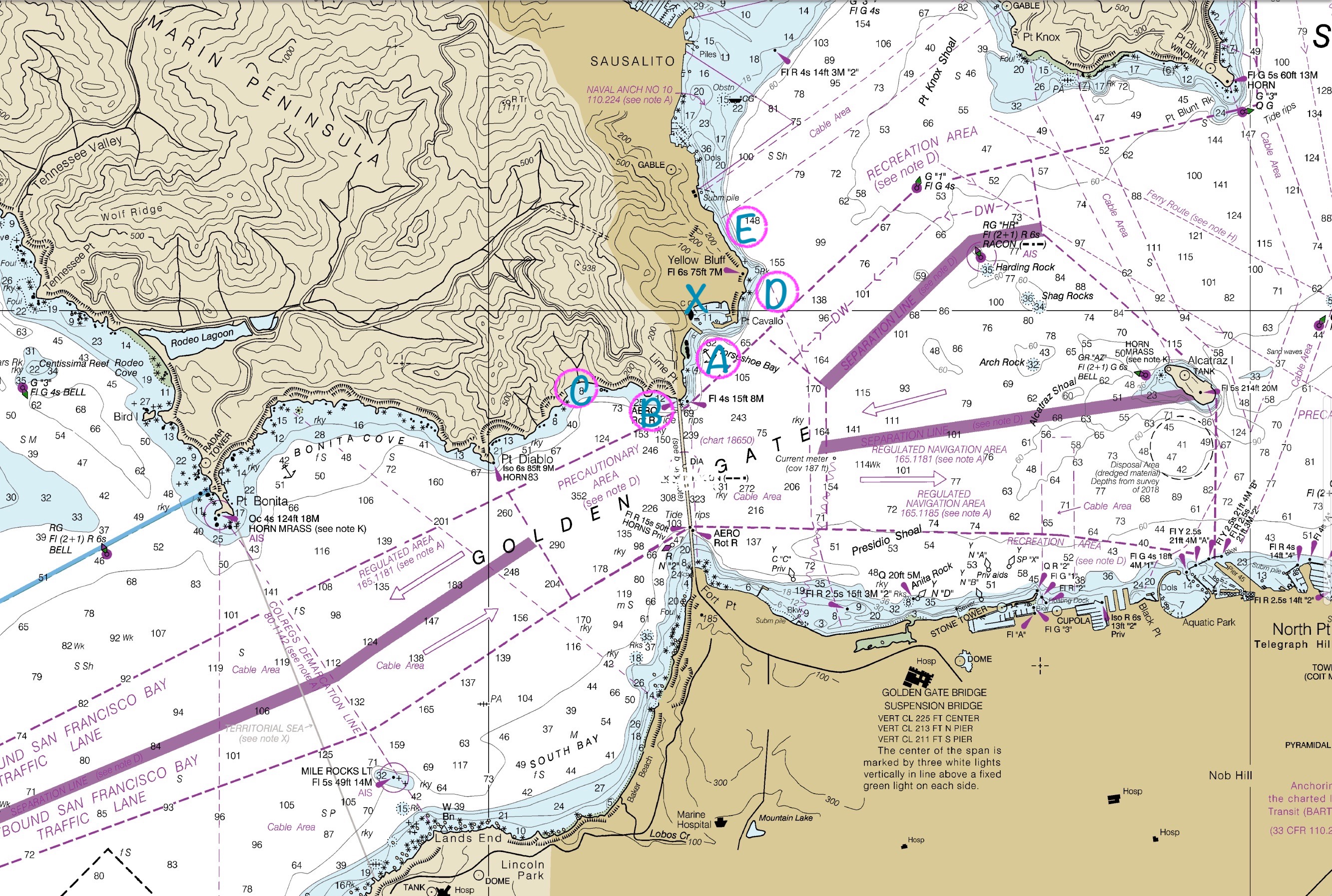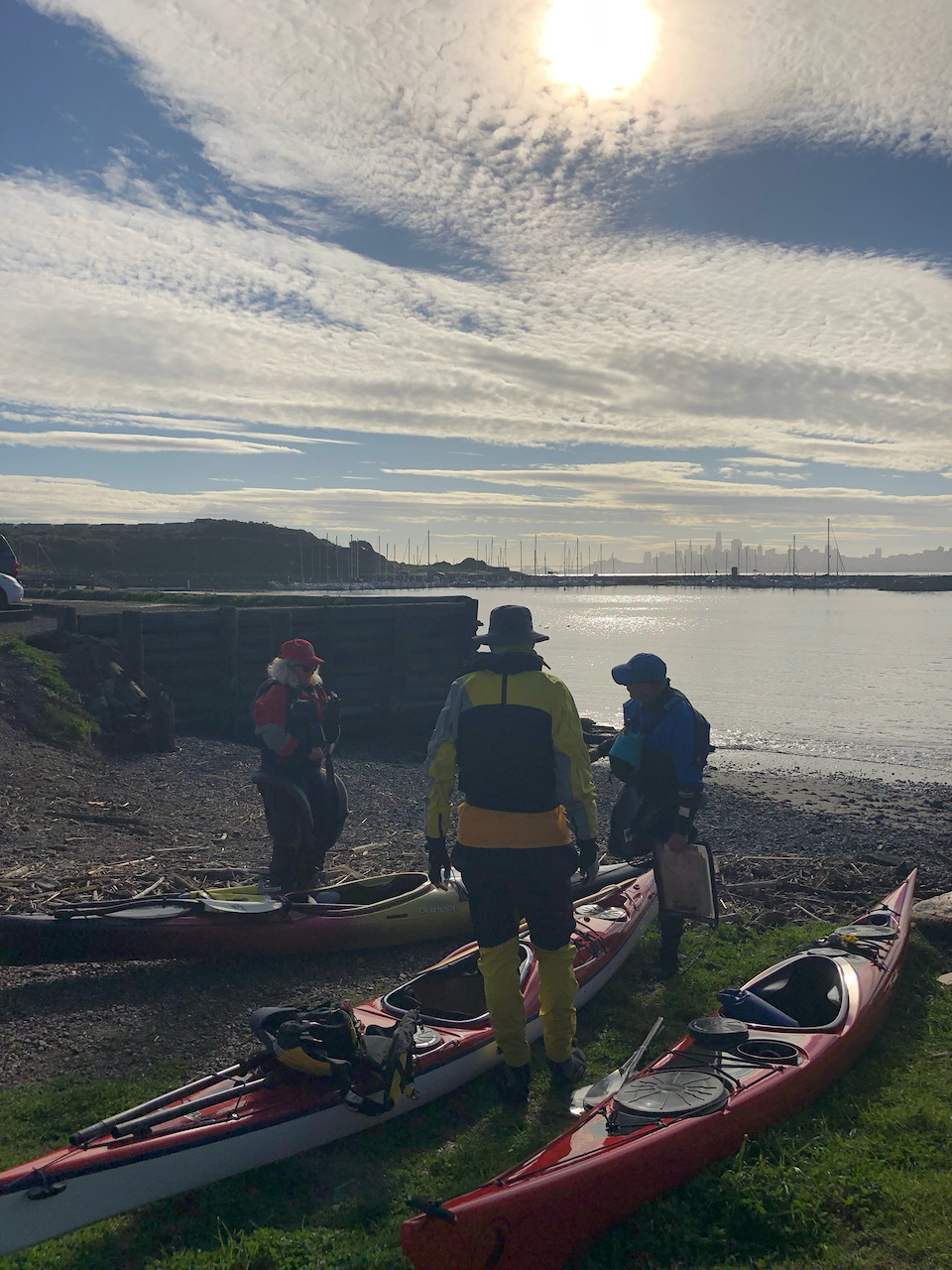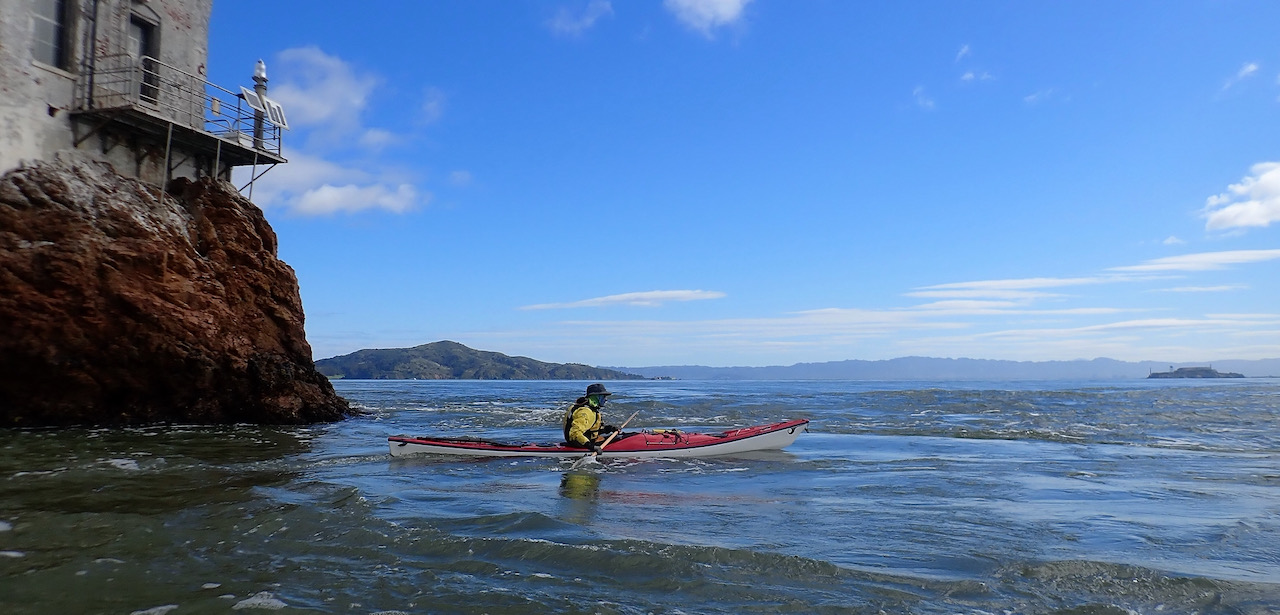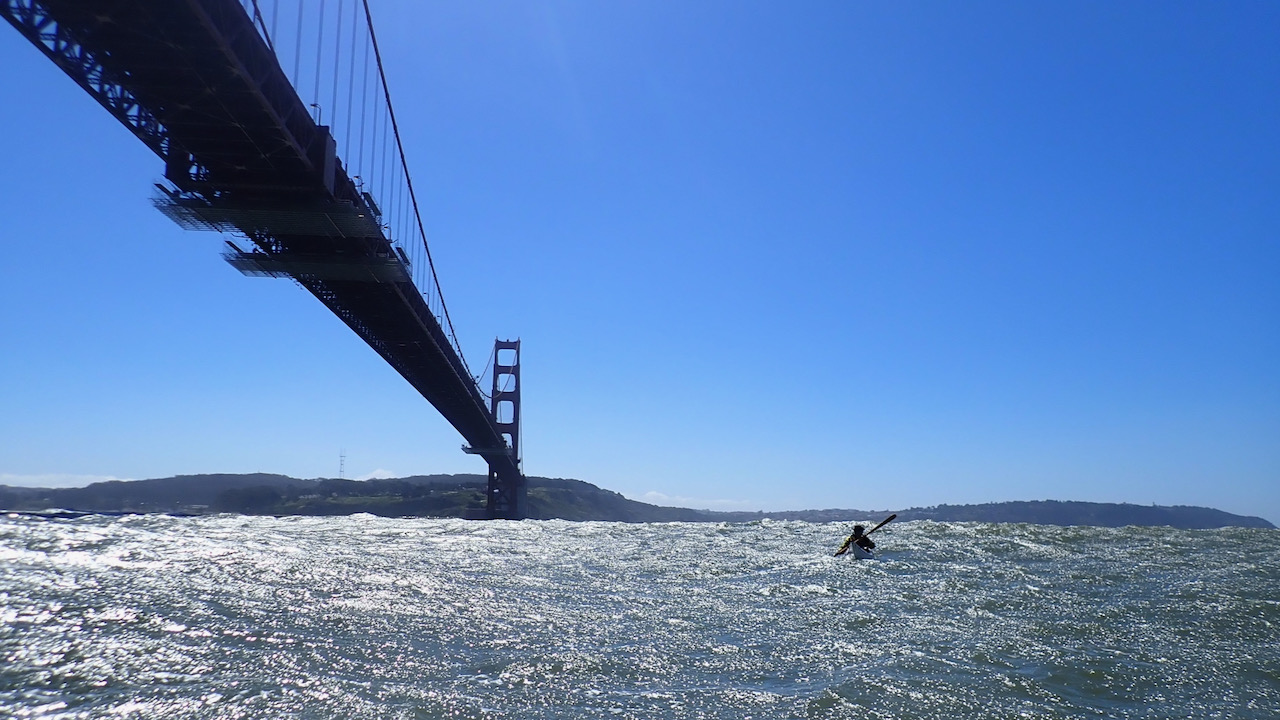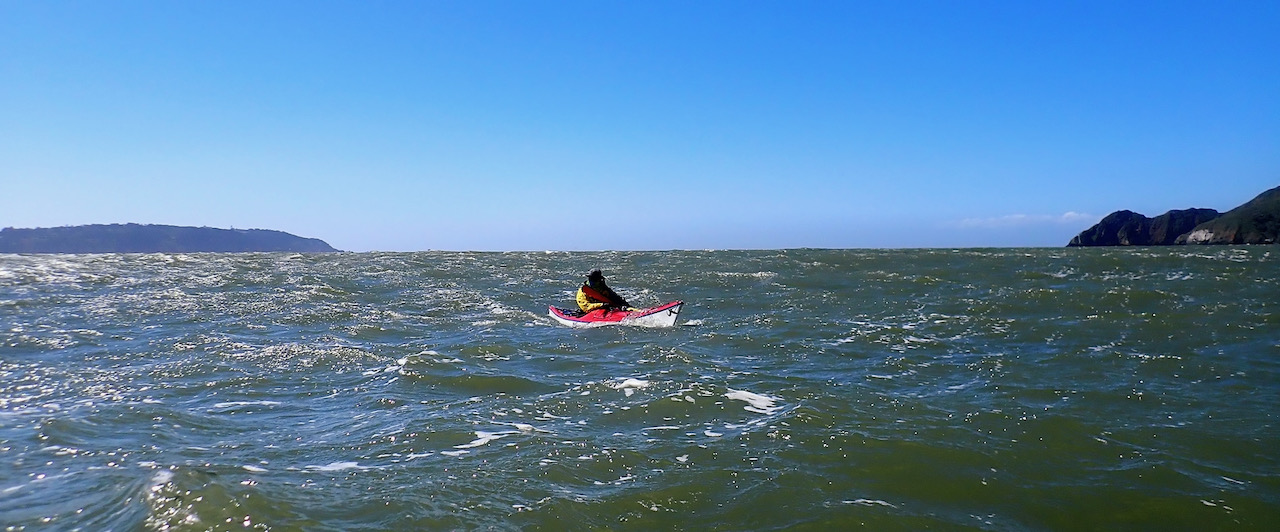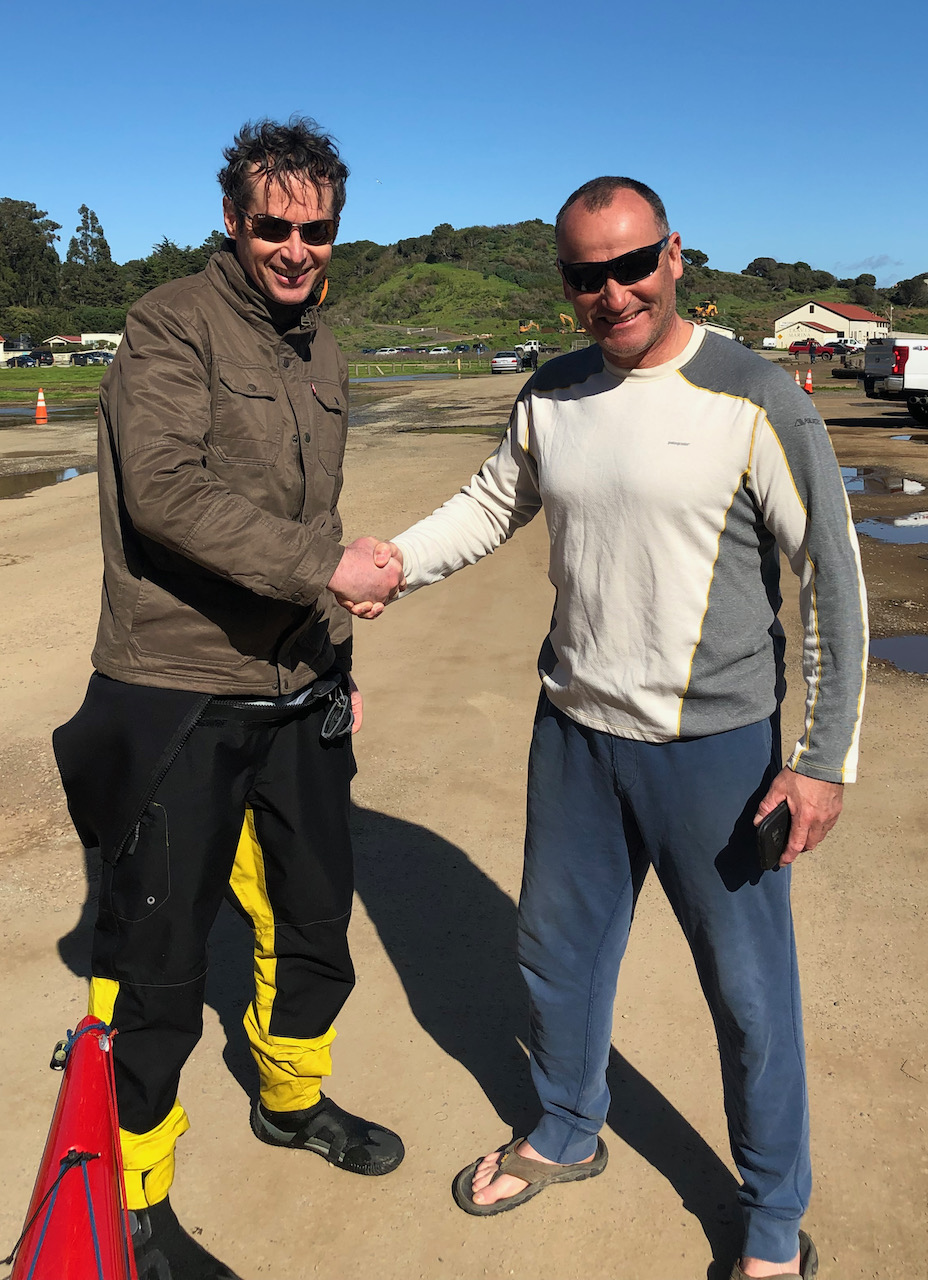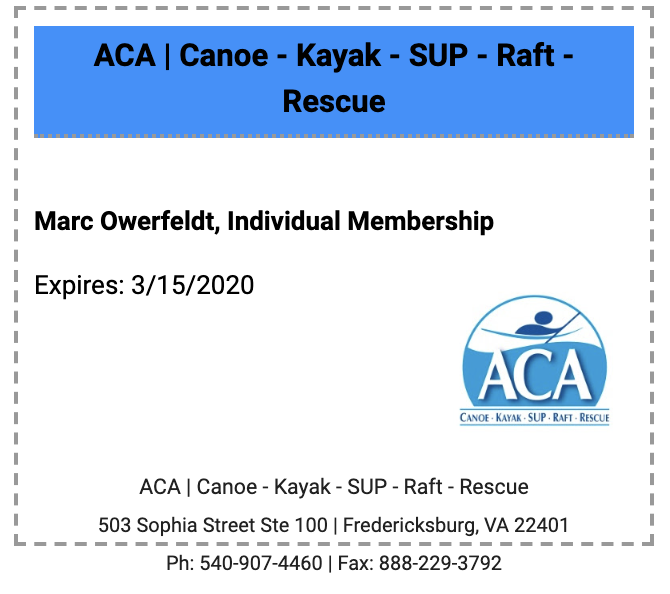Sean Morley had set up a Level 3 Assessment for Sea Kayaking and invited me to join.
Posted on March 12, 2019
Sean Morley had set up a Level 3 Assessment for Sea Kayaking, under the umbrella of the American Canoe Association (ACA), and invited me to join them to 'make it more realistic'. Well, I had never crossed paths with the world of organized paddling and always wanted to see what these assessments are all about. We decided to turn this into a mini vacation, take the kids out of school for a couple of days and to stay at a hotel on the Tiburon peninsula.
The test took place at Fort Baker / Horseshoe Cove, right where the Coast Guard is based. The map below details the locations.
As it turned out the assessment was no joke and I almost failed it. Not for my paddling skills, those were advanced enough to meet all challenges and probably saved the day, but I was lacking in know-how and general preparedness.
Here's how the day would unfold:
- We launched at the Coast Guard station, point (X) on the map.
- Then we ran some paddling drills in the area marked as (A).
- Next was a quick dash to the other side of the Golden Gate Bridge, point (B) where we played in the eddy pools that formed at the base of the bridge.
- Onwards to (C) where we tested our beach landing and navigation skills.
- Then a fast downwind run back to (A) where towing skills were tested.
- We then looped around towards Yellow Bluff (D) for kayak rolling and assisted rescues.
- After a break at (E) we tested more paddle strokes and self-rescues.
- About six to seven hours later we were back to (X).
We paddled out of the cove and, as a first test, ran figure 8s around a rock formation in area (A). Water was surging around the rocks and made this test a bit of a challenge. Sean asked us to repeat this focusing on edging with a low-brace recovery and, finally, circling the rocks in moving water backwards with edging and high-brace recovery. This, as Sean explained, is a great test to assess the skills of fellow paddlers in case you don't know them well and before you head too far into the unknown.
Our next stop was on the other side of the Golden Gate Bridge, sector (B). A strong ebb current took us out in a hurry and a large eddy had formed behind the base of the bridge. Sean explained that this was L4 stuff and not part of the test but that we should take advantage of it and play for a while. Sean demonstrated how to paddle across the eddy line and carve into the main current and soon Kathy and I were taking turns. I had come across similar currents before but always tried to limit exposure and risk since I usually carried fishing gear and often quite a lot of fish. This time we were trying to get into the thick of it and it was fun!
The wind began to pick up and we continued paddling west while hugging the shoreline. Soon we reached area (C) and Sean prepared us for a beach landing. The swell periods where long and carried some power as they crashed ashore. I saw Kathy's hesitation, she wanted that I go first. No problem, this was a familiar terrain, I had navigated many precarious beach landings with a heavy fishing kayak at Pigeon Point and this one was not half as bad. I pretty much nailed it and then helped catching Kathy as she came in.
We took a break at the beach and Sean used the time to test our navigation skills. The task was to locate our exact location on the map. I knew that I was in some trouble because I didn't bring an adequate map but just a printout with fonts too small to read. When Sean asked how our location could be determined I knew the answer: triangulation. However, I had never done this. I proceeded to take two bearings with my handheld compass, one to the base of the far end of the Golden Gate Bridge, the other to Mile Rocks Light. So far so good. I knew everything about magnetic declination, had adjusted my compass accordingly and so forth. Yet, I had trouble transferring the bearings onto the map. In hindsight that is such a simple thing and will never again be a problem, but in the moment at the beach I couldn't do it. Sean stepped in and helped out. After that Sean gave us tips about using our paddles and observing the background behind ships to estimate if a ship was comping towards us on collision course of whether it would chart a course clear of our own.
We hopped into our kayaks and launched from the beach into surf and a wind which now had increased to over 20 mph. Fortunately, or not since Sean had planned the day, we were going back east towards the Golden Gate Bridge. Pushed by the wind we were virtually flying back to area (A).
There, at (A), Sean asked me to tow him and Kathy, pretending that Kathy was injured and that he would assist her. Now it became clear that my tow rope was inadequate and Sean offered his for the job. It takes a certain technique to pass the rope under one boat and clip it to the other in a specific order. You pass the end of the tow rope underneath the forward static lines of the able-bodied paddler's boat and clip it from underneath onto the static lines of the injured paddler. The reason is that the non-injured paddler can scoot up and release the clip if needed. The clip needs to be connected from underneath so that it won't self-release when sliding against the deck line guides. After not too long it became exhausting to two two boats and Sean urged me to push harder. I made it past Horseshoe Cove and then, thankfully, was relieved of being the locomotive.
We moved on to area (C) when all the sudden Sean rolled his kayak. I didn't think that rolling was part of the L3 assessment, but since I can do this, too, I thought what the heck and joined him in the rolling action. Sean coaxed Kathy into rolling her boat and it became clear that she didn't like to be upside down in a sea kayak as she quickly bailed and even let go of her paddle. That's not a good move, of course. I'd rather die than let go of my paddle (while at sea).
We followed up with a variety of assisted rescues. Sean called me to come over to rescue him and promptly flipped his boat with just his hands sticking out to either side. I had to react swiftly and approached him quickly from forward at an angle to make sure that his hand would catch my bow or at least something form my boat. It worked out and Sean rolled up using my bow as a pivot point. Then Sean asked me to go inverted so that Kathy could save me. This was not a comfortable situation for me as I never relied on others so that I could breathe again. I just hoped that Kathy was up for it and would not miss me altogether. Soon I felt her bow pushing into my extended arm. I grabbed it and rolled up as well. Phew, I guess I passed another test.
A few more rescues followed and then we took a break on a beach near Yellow Bluff at (E). We ate our snacks and discussed what we learned so far. After the break we went back to (D) and ran various draw stroke drills. My hanging draw didn't work out as well as I would have liked but Sean let it slide. It is a stroke I rarely use and should practice it some more I thought to myself.
We then moved out to our final test, an efficiently performed self-rescue. Sean asked me about a paddle float. I took out my float and assured Sean that I knew how to use it, but my preferred move is a re-enter & roll, something that is many times faster than inflating a paddle float and going back into the boat with a heel hook. Also, the re-enter and roll holds up in conditions while the paddle float method is much tougher to pull off when the ocean is angry. Sean indicated to go ahead with a re-enter & roll. Kathy used a paddle float in her self-rescue while I watched her for a while, threw in a few couple extra rolls on either side, and then went for a wet exit with subsequent re-enter & roll. Long after I completed my self-rescue Kathy also made it back to an upright position with her boat pumped out and dry. It is clear that once you master a re-enter & roll you're not going back. The only possibility I could see is a re-enter & roll with paddle float if you're not fully confident in your rolling ability. I'm past that point, though.
On the way back to Horseshoe Cove Sean came over to tell me that a) I'm really smart (his words, not mine) and b) I'm a good athlete and paddler with solid skills and c) that I passed the assessment.
Oh man, I was rather happy that I got this under my belt. I never doubted my paddling skills but there were some knowledge pieces, as Sean did not forget to point out, that I need to work on. I'm a diligent person and already addressed my issues with:
- triangulation and transferring bearings onto a map
- tow-rope (which I ordered)
- missing deck compass (already purchased and installed)
In summary: I now have a lot more respect for Level 3 of the ACA curriculum. The assessment is a serious test and difficult to pass if you don't have solid paddling skills and if you - like me - didn't take preparation classes leading up to it.
